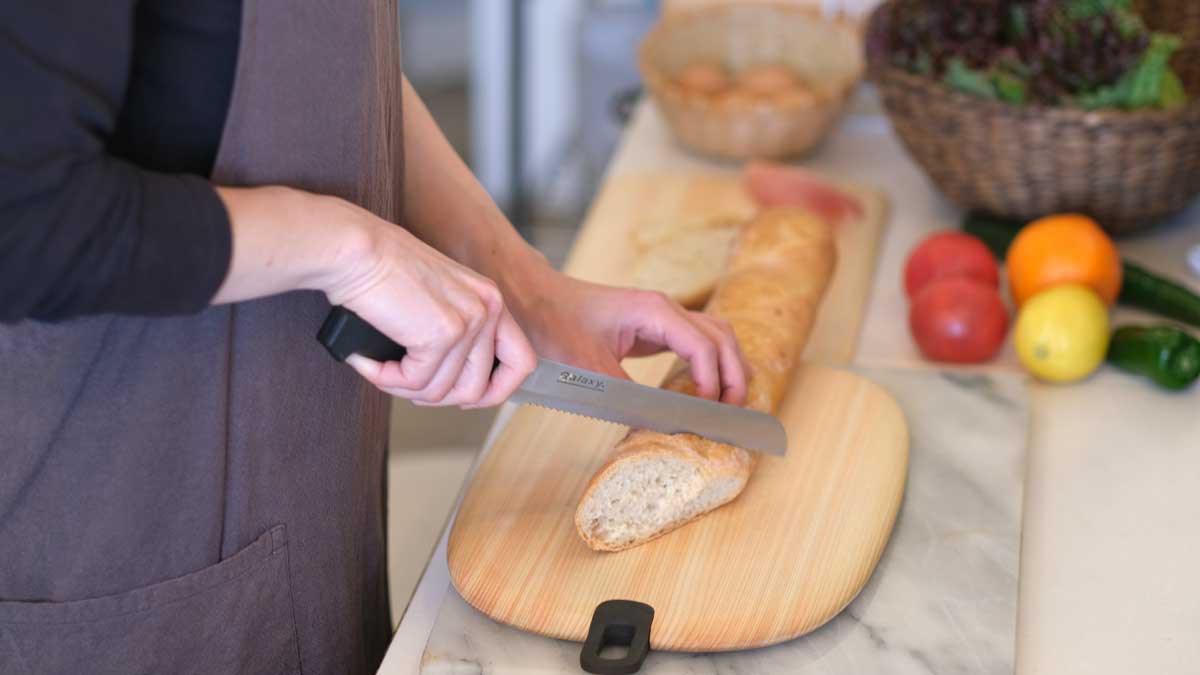point 1
During use
Wet lightly
- Before each use, lightly wet both sides of the cutting board, and wipe once to remove excess water.
This prevents stains and odors, and stops ingredients from slipping.
In addition, by keeping the underside wet, it prevents the cutting board itself from slipping. Use both sides
- You can use the branded mark to designate one side where meat and fish are cut and one side where vegetables are cut. This prevents the bacteria in meat and fish from coming into contact with the vegetables.
You can also wash it during use.
- When you cut raw ingredients such as meat and fish, it is recommended to rinse the cutting board during use.
In addition, if you leave the preparation of such raw food for last, you can save yourself the trouble of rinsing the board frequently while cooking. Don't chop too hard with a kitchen knife
- Hinoki cutting boards are not designed for heavy chopping, such as hitting the board hard with the blade of a knife.
There is a risk that the surface may be damaged by deep cuts or by knife marks that remove the top layer.
point 2
When washing
Wash directly after use (be sure to wash both sides)
- After use, rinse the food residue from the board as soon as possible.
If left unwashed, the color and smell of the ingredients will seep into the wood of the cutting board, and it will be easier for bacteria to breed.
Be aware that washing fish and meat residue directly with hot water at first will cause the proteins to harden, and trap unwanted odors in the board.
Be sure to wash both sides of the cutting board.If only one side becomes wet, it may cause the wood to warp, and the next time you use it the unwashed surface may be used by mistake. When washing with a sponge
- Wash with a soft sponge and mild dishwashing detergent.
After washing, rinse thoroughly so that no detergent remains. When washing thoroughly with a scourer
- When you want to wash it thoroughly, such as after cutting raw meat or fish, or handling ingredients with strong pigments, scrub it with a Yashi (palm) or Shuro (Hemp Palm) scourer.
Scrubbing perpendicular to the grain will damage the wood, so scrub parallel to the grain to clean.
However, please do not use a metal scourer as this will scratch the wood.
After scouring, wash again with a mild detergent and disinfect the board. Drain well after washing
- One of the major causes of black stains and mold in wooden cutting boards is storage while damp.
Dry the cutting board completely before storing.
Use kitchen paper or a clean cloth to wipe off moisture.
After that, dry in the shade in a well-ventilated place, if possible. Store the board standing vertically
- The long side of the cutting board is called the Koguchi (cut end), which is the most difficult to dry and is prone to dark stains and mold.
When storing upright, stand the board vertically so that water does not accumulate in this horizontal side.
If you cannot store it vertically because of space issues, drain thoroughly before storing.
point 3
Other
Alcohol disinfection is OK.
- Alcohol disinfectant sprays can also be used.
When the cutting board is wet, the disinfectant is not as effective, so wipe off the moisture and dry to some extent before using. Use of bleach
- Bleach can be used, but may cause the wood to react, leaving black or brown stains.
In addition, if it is not thoroughly washed off after use, bleach may remain in the wood.
When using kitchen bleach for Hinoki cutting boards, be sure to dilute it as directed and do not use it for a long time.
Do not use foam-type bleach.
Please note that black pigments and mold often penetrate the inside of cutting boards, and it is difficult to bleach them out. Use of baking soda and cleansers
- Scrubbing clean with baking soda or a cleanser is possible.
However, both have an abrasive effect, so excessive scouring may damage the board surface.
In addition, there is a risk of a reaction in the wood, resulting in black or brown discoloration. I heard that lemon and salt are effective against odor or discoloration…
- The cutting board can be bleached by rubbing the surface with coarse salt on a cut lemon or lemon slice (However, it will not remove all stains completely.)
Lemon alone is effective, but coarse salt has an abrasive role.
The citrus scent also removes odor from the cutting board. Can't I use the dishwasher?
- Wood cutting boards are generally not dishwasher-safe due to possible warping or cracking when exposed to high temperatures.
Daiwa Sangyo is able to manufacture dishwasher-safe Hinoki cutting boards. Drying in direct sunlight
- As with the use of dishwashers, drying at high temperatures will result in the cutting board cracking and warping, so do not dry in the sun.
